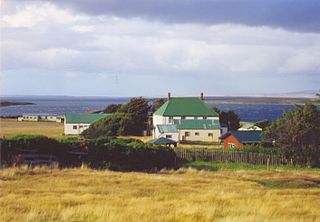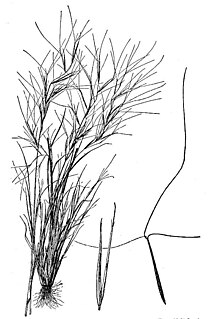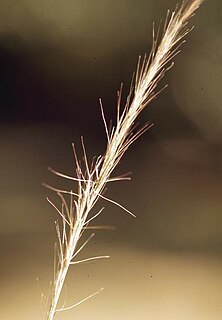Wiregrass is a common name for several plants
Wiregrass may refer to:
- Poaceae grasses
- Aristida (three-awns), especially Aristida stricta (Pineland Three-awn), Aristida junciformis and Aristida purpurea (Purple Three-awn), of subfamily Arundinoideae
- Eleusine indica (Indian Goosegrass) of subfamily Eragrostideae
- Sporobolus indicus (Smutgrass) of subfamily Chloridoideae
- Cynodon dactylon (Bermuda Grass) of subfamily Chloridoideae
- Ventenata dubia of subfamily Pooideae, native to the Mediterranean and naturalized in western North America

Aristida purpurea is a species of grass native to North America which is known by the common name purple three-awn. This grass is fairly widespread and can be found across the western two thirds of the United States, much of southern Canada and parts of northern Mexico. It is most abundant on the plains.

Eleusine indica, the Indian goosegrass, yard-grass, goosegrass, wiregrass, or crowfootgrass, is a species of grass in the family Poaceae. It is a small annual grass distributed throughout the warmer areas of the world to about 50 degrees latitude. It is an invasive species in some areas.

Sporobolus indicus is a species of grass known by the common name smut grass.
- Other plants
- Juncus tenuis (Slender Rush) of the rush family
- Polygonum arenastrum (Common Knotweed) of the knotweed family
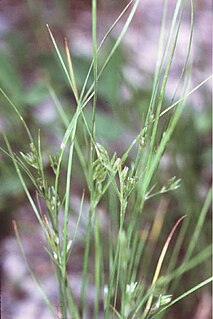
Juncus tenuis, the slender rush, is a clump-forming, round-stemmed perennial in the Juncaceae. Slender rush grows to be between 15 and 60 cm tall. Generally considered a weed, it is rarely sold by retailers as a household container plant. Where it is introduced, it is colloquially called path rush, field rush, slender yard rush, poverty rush or wiregrass.
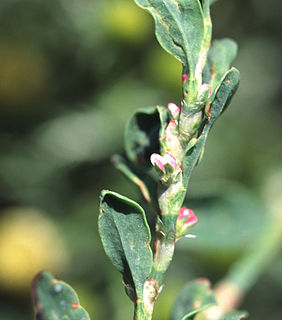
Polygonum arenastrum, commonly known as equal-leaved knotgrass, is a summer annual flowering plant in the knotweed family Polygonaceae. It is native to Europe and can be found on other continents as an introduced species and a common noxious weed. Other common names include common knotweed, prostrate knotweed, mat grass, oval-leaf knotweed, stone grass, wiregrass, and door weed, as well as many others, knotweed was first seen in North America in 1809 and is now seen across much of the United States and Canada.

Poaceae or Gramineae is a large and nearly ubiquitous family of monocotyledonous flowering plants known as grasses, commonly referred to collectively as grass. Poaceae includes the cereal grasses, bamboos and the grasses of natural grassland and cultivated lawns and pasture. Grasses have stems that are hollow except at the nodes and narrow alternate leaves borne in two ranks. The lower part of each leaf encloses the stem, forming a leaf-sheath. With around 780 genera and around 12,000 species, Poaceae are the fifth-largest plant family, following the Asteraceae, Orchidaceae, Fabaceae and Rubiaceae.

Aristida is a very nearly cosmopolitan genus of plants in the grass family. Aristida is distinguished by having three awns (bristles) on each lemma of each floret. The genus includes about 300 species found worldwide, often in arid warm regions. This genus is among those colloquially called three-awnswiregrasses, speargrasses and needlegrasses. The name Aristida is derived from the Latin "arista", meaning "awn".
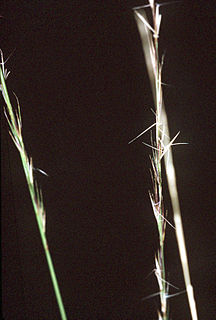
Aristida stricta is a warm-season grass, native to North America, that dominates understory vegetation in sandhills and flatwoods coastal plain ecosystems of the Carolinas in the Southeastern United States. It is known as wiregrass and pineland three-awn grass.




